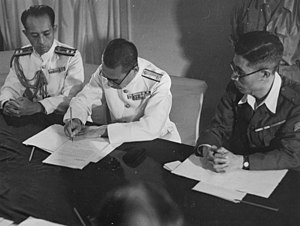| Operation Jurist | |||||||||
|---|---|---|---|---|---|---|---|---|---|
| Part of the Second World War | |||||||||
 Imperial Japanese Navy Rear Admiral Jisaku Uozumi signs the surrender of Penang aboard HMS Nelson on 2 September 1945. He fainted shortly afterwards and was rushed to hospital.[1] | |||||||||
| |||||||||
| Belligerents | |||||||||
|
|
| ||||||||
| Commanders and leaders | |||||||||
|
|
| ||||||||
| Units involved | |||||||||
|
|
| ||||||||
| Strength | |||||||||
|
42,651 infantry[3] 2 escort carriers 1 battleship 1 light cruiser 3 destroyers 3 landing craft[4] | 26,000 infantry[5] | ||||||||
| Casualties and losses | |||||||||
| None | 26,000 captured | ||||||||
Operation Jurist referred to the British recapture of Penang following Japan's surrender in 1945.[6][7][8][9] Jurist was launched as part of Operation Zipper, the overall British plan to liberate Malaya, including Singapore.
While a larger Allied fleet sailed on to Singapore through the Malacca Strait under Operation Tiderace, a detachment of Royal Navy warships, led by Vice Admiral Harold Walker, moved towards Penang Island, arriving off the island on 28 August 1945. The Japanese garrison in Penang surrendered on 2 September and a party of Royal Marine commandos landed on Penang Island the following day, thus returning Penang to British rule.
Consequently, Penang became the first state in Malaya to be liberated by the British; Singapore would only be formally surrendered to the British on 12 September, while the rest of Malaya was subsequently liberated in the following weeks.
- ^ "After some delay, and a failure to attend an earlier meeting, the Japanese local commander, Rear Admiral Jisaku Uzumi, came aboard HMS Nelson on the evening of 2 September, wearing the DSC he had earned as Britain's ally in the 1914-18 war, and surrendered the garrison. He fainted and was rushed to the hospital; the military policemen who carried him there took his sword as a souvenir." Bayly & Harper, page 49
- ^ Sir Harold Thomas Coulthard Walker, RN
- ^ 46 Indian Beach Group, Morib
- ^ HMS NELSON - Nelson-class 16in gun Battleship
- ^ "The real Japanese surrender" (PDF). The Sunday Times. 2005-09-04. Archived from the original (PDF) on 2008-01-19. Retrieved 2009-12-09.
- ^ Barber, Andrew (2010). Penang At War : A History of Penang During and Between the First and Second World Wars 1914–1945. AB&B.
- ^ "BBC - WW2 People's War - Operation Jurist and the end of the War". www.bbc.co.uk. Retrieved 2017-03-11.
- ^ "JAPANESE SIGN THE SURRENDER OF PENANG ABOARD HMS NELSON (3/9/1945) | colonialfilm". www.colonialfilm.org.uk. Retrieved 2017-03-11.
- ^ Kratoska, Paul. War and Occupation in Penang, 1941–1945. Singapore: National University of Singapore.
